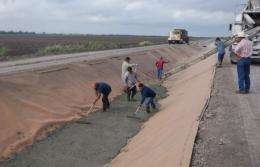What's the best irrigation canal liner?

There are an estimated 1.2 million acres of agricultural land in Texas irrigated via canals, and many are in need of renovation, according to a Texas AgriLife Extension Service expert.
Historically, irrigation canals were basically just earthen ditches, according to Dr. Guy Fipps, AgriLife Extension irrigation engineer, College Station. But due to the burgeoning water shortages over the past 15 years, there has been an increase in the awareness of the need to reduce water loss from canals through seepage.
Traditionally, the most common renovations were to replace smaller canals with pipelines and line larger canals with concrete, Fipps said. But lining canals with concrete is expensive and requires significant upkeep, particularly in Texas’ “shrink-swell” soils.
However, today irrigation districts have options other than just concrete.
“There is a revolution in material sciences happening, with many new and innovative products coming on the market, including synthetic liners that are promoted for use in many applications,” he said.
These new synthetic materials offer better, less-expensive choices than lining canals with concrete alone, Fipps said. Choosing the right liner, however, is not a simple task. There are some that are more suited to a given situation – and an irrigation district’s budget. There are also tradeoffs to be considered, such as ease of installation, durability, resistance to human and animal traffic, and cost.
To help irrigation districts make the best choices, Fipps and his associates recently completed a seven-year evaluation of nine synthetic canal liners in the Lower Rio Grande Valley.
“Initially, we used a very simple visual rating system,” Fipps said. “However, we quickly noticed that exactly the same material would fail completely in one location while remaining in excellent condition in others. Thus, our visual rating system evolved significantly over time as we sought to document the causes of such site-specific performance.”
Fipps and his team wound up using a two-step process, combining a visual rating scale and quantitative analysis.
“The rating gives us an overall indicator of the condition of each project, and how the material fairs over time,” he said. “The quantitative analysis is used to interpret the ratings and to identify the factors that are likely causing lower ratings than would otherwise be expected.”
Some of the factors affecting performance were expected by Fipps and his team members, who have decades of experience evaluating and improving irrigation systems in Texas.
One obvious source of problems is improper installation, he said. Irrigation districts are always trying to keep their costs low in order to minimize increases in fees paid by their farmers and other customers. Some choose to do the installation themselves, and this can lead to various problems if the staff is not sufficiently trained.
Poor installation issues include poor anchoring of the liner at the top of the canal, improper seams of liners around gates, valves and other structures, as well as inadequate stretching of liners at installation.
“Water seeping under the top anchor can result in floating and even buckling of concrete being used as a protective barrier,” Fipps said. “Proper seaming of materials around structures, gates and valves takes skill. District personnel may not have sufficient training or use the right products.”
Other factors that need to be taken into account when choosing a liner are smoothness and stability of the material underneath the liner.
“Some of the thinner liners definitely shouldn’t be used over cracked concrete as they are easily pierced,” he said.
And traffic — both human and animal — also turned out to be significant factors.
“Do kids swim in the canals?” Fipps said. “Much of what we classified as ‘unintentional damage’ appeared to be caused by kids grabbing onto folds or loose spots in the liners while pulling themselves out of the canal.”
Also, cattle hooves can puncture some of the thinner materials, he noted. Other damage was caused by mowing near where the liner is anchored to the top of the canal.
“Then there’s the maintenance factor,” he said. “Timely maintenance and minor repairs can prevent small problems from becoming serious.”
Fipps and his associates rated the following types of liners:
– Polyester with protective barrier of 2 to 3 inches of shotcrete.
– PVC with protective barrier of 2 to 3 inches of concrete.
– Polypropylene (Two polypropylene layers over a coarse fabric reinforcement).
– Ethylene propylene diene monomer, commonly known as EPDM, rubber (non‐reinforced, 0.045 inch thick).
– Polyurethane (two layers of plastic over a non-permeable reinforcement).
– Thermoplastic PolyOlefin, commonly known as TPO, geomembrane (0.045 inch thick).
– Reinforced Ethylene propylene diene monomer (0.045 inch thick).
– Reinforced FPP-R, (a rubber-based product over a non-permeable membrane).
So what’s the best overall renovation?
“It’s a synthetic liner with a protective barrier on top of concrete or shotcrete.” he said.
Beyond that, it gets complicated, Fipps said, depending on kids, cows, mowing, installation expertise and, of course, money.
“Also, there’s little difference between the cost of the various liners, but skill levels in the field vary widely,” he said.
The teams’ full report on the seven-year study can be found at the AgriLife Extension website for irrigation district information at idea.tamu.edu .
Provided by Texas A&M University

















